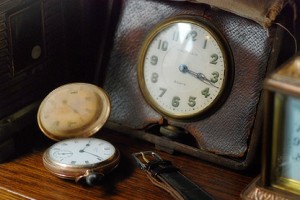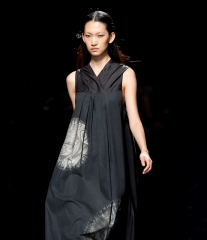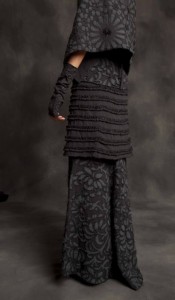
「時」
現在が点、過去が線、将来が形。
点からなる線、線からなる形。
点がなくては線ができず、線がなくては形ができず。
点となる時、線となる時、形となる時。
全ては繋がる一つの時。
Translation: A Moment
The present, a dot. The past, a line. The future, a shape.
A dot becomes a line. A line a shape.
Without a dot, a line can't be created. Without a line, we can't create a shape.
A dot in a moment. A line in a moment. A shape in a moment.
Everything linked together, in a single moment.

The poem was introduced to me recently by the Japanese fashion designer Sara Arai, as she tried to explain the personality of her luxurious pret-à-porter collection araisara.
Originally specialising in made-to-order couture pieces, Ms. Arai launched araisara with the AW 2009/10 collection. And – very unique in the fashion landscape, certainly in Japan – she works with craftsmen that are the heirs to traditions accumulating over 1200 of history: a scattered group of rare dyers and weavers that still know, and are able to recreate recipes from the Heian Period (794 – 1185 AD).
While the recipes indeed have survived, the dye stuffs and water quality has changed in the thousand years since, and the exact processes of most techniques and procedures have been partially forgotten while being carried forward into the present creating Kimono’s for special occasions only. Hence, only vast amounts of experimentation of highly skilled, seasoned craftsmen slowly, slowly achieves to revert back to the quality of historic results. With araisara they designer not only gives this knowledge a new lease of live, but also enriches contemporary fashion by fusing it with these old traditions.
The reason however, why the poem keeps ringing in my ears has only little to do with Ms. Arai’s achievements as designer, but very much with the fundamentals of her work, and how it links to ‘ethics’ in the fashion world, which come alive through the products of specific designers and collections:
With everything with do, we create in the present, we link to and build onto our past results and insights. And the combination of the two is how we creates the shape our future is going to take.
Or expressed less new age, and more hands-on: The the fashion world looks like in the present, is a direct consequence of decisions of the past, good ones and less good ones. By looking at the past critically, improving what went wrong and keeping what worked – from techniques, to chemicals, fibres and manufacturing processes – , we change and and create a future oriented industry that is willing and ready to innovate, and that has more of the ‘good stuff’ and less of the rest.

It is in fact a perspective that only very few individuals, let alone brands, across the whole industry are able and willing to take. There are of course of few example which are somewhat close. Patagonia, for example, overall walks their talk, and changes the industry from within by consciously taking a critical, innovative stance.
Alamaba Chanin is yet another of those examples where the present and past are linked, while creating a somewhat different future for all involved. She, too, has taken the skills of communities, highly cherished in the past, nearly extinct in the present, and has applied them to contemporary fashion, and while giving them a new lease of life, created on the way highly rare, desirable items.
What might seem initially as turning the clock back in time, however, is probably more like turning the clock fast forward into a yet far away future: one where resources will be scarce again; where the battle between using agriculture land for either fashion or food will have a clear cut answer given an ever increasing, and denser world population; where make-do-and-mend will be part of our daily habits again even though many of us would much prefer to go back our ‘discard it all’ habits.
In the present, learning from the past, creating the future to the truly best of our knowledge and abilities. In essence, this is what ethical fashion is all about.
A Moment
The present, a dot. The past, a line. The future, a shape.
A dot becomes a line. A line a shape.
Without a dot, a line can't be created. Without a line, we can't create a shape.
A dot in a moment. A line in a moment. A shape in a moment.
Everything linked together, in a single moment.

